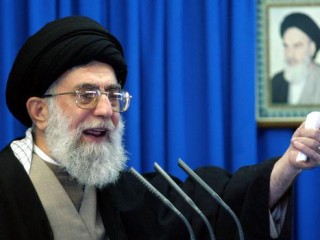
Ayatollah Ali Khamenei biography
Date of birth : 1939-07-17
Date of death : -
Birthplace : Mashhad, Iran
Nationality : Iranian
Category : Politics
Last modified : 2010-07-22
Credited as : Politician and Supreme leader of Iran, religious leader, World's political leader
0 votes so far
He was president of Iran from 1981 to 1989, and has been Supreme Leader of Iran since June 1989 when the Assembly of Experts selected him to succeed Ayatollah Ruhollah Khomeini. He has been described as one of only three people having "important influences" on the Islamic Republic of Iran (the other two being the founder of the republic, Ayatollah Ruhollah Khomeini, and the president of Iran for much of the 1990s, Ayatollah Akbar Hashemi Rafsanjani). So far, the biggest challenge to his leadership has been the mass protests following the June 2009 presidential elections. Khamenei, however, continued to strongly support Mahmoud Ahmadinejad's policies and re-election.
Khamenei was the victim of an attack aimed to assassinate him in June 1981 which paralysed his right hand.
Ayatollah Ali Khamenei has been Iran's supreme leader since 1989. He is the absolute authority regarding government and religious matters in the Persian Gulf country. Khamenei and President Mahmoud Ahmadinejad seemingly solidified their power in the national election of 2009, though protests and accusations of voter fraud followed.
Rose with Revolutionary Leadership
Khamenei was born in Meshed, in northeastern Iran. Raised in a religious family, he studied theology at age 18 in Najaf, Iraq, a holy city of the Shiite Moslem religion. The following year he moved to Qum, Iran, and studied under clerics. "Like other students, he sat at the feet of masters, taking painstaking notes on lectures and arguing intricate and obscure points of the Koran," the New York Times wrote.
In 1963 Khamenei joined other students in protests against the rule of Shah Mohammad Reza Pahlavi led by Ayatollah Ruhollah Khomeini, that resulted in police and soldiers storming Feyziyah Seminary and killing protesters. After Khomeini went into exile the following year, Khamenei went back to Meshed. Under the scrutiny of Savak, the shah's secret police, Khamenei was jailed six times over 14 years. When released in 1978, he lived in Iranshar and Jioft, both small towns.
Khamenei joined the street fighting that led to the revolution of 1979, in which Khomeini returned from exile and replaced the shah. Khamenei rose through the ranks of the religious leadership. In the early 1980s, Khamenei spoke frequently and angrily at the University of Tehran, wielding a rifle while vilifying the United States and neighboring Iraq. Khamenei "was the archetype of the hard-line mullahs who came to dominate the Islamic Republic's government, its judiciary, and Parliament," according to the New York Times.
Khamenei was Khomeini's personal representative on the Supreme Defense Council, which monitored the country's war with Iraq. He was also the ayatollah's liaison with the government and served on the country's governing Revolutionary Council. In addition, he helped found the Islamic Republican Party, serving as its secretary general.
He dodged an assassination attempt in 1981, when a bomb concealed in a tape recorder exploded in front of him as he spoke in Tehran, the nation's capital. The explosion injured his vocal chords and right arm. Later that year, he was elected president at age 42, becoming the first clergyman president since the revolution. In the three months before his election, Khamenei implemented a crackdown resulting in the deaths of about 1,000 political opponents. When Khomeini died in 1989, Khamenei became the supreme leader.
Took Hard Line against Protesters
In the June 12, 2009, presidential election, Khamenei's protégé, Ahmadinejad, seeking a second term, was officially announced the winner with nearly two-thirds of the vote. Khamenei and other hard-liners called it a victory in the power struggle against former president Ali Akbar Hashemi Rafsanjani. Though loyal to Islamic rule, Rafsanjani was perceived as more pragmatic in economic, international, and domestic social matters. Inflation, widespread unemployment, and skirmishes beset Iran in the years leading up to the election.
Khamenei endorsed the re-election of Ahmadinejad, who under Iran's constitution needed the supreme leader's approval. Meanwhile, about half a million protesters stormed streets in Tehran and other cities, disputing the election's outcome. "The results, surprising to many Iranians and political analysts, prompted sometimes violent demonstrations across the country," CNN.com reported.
Khamenei called for an inquiry into allegations of voter fraud. But he urged the protesters to stay off the streets, and said opposition leaders compliant with protests "would be responsible for the bloodshed and chaos," as quoted by Nazila Fathi of the New York Times. Fathi called the crisis Iran's most severe since the 1979 revolution.
Clerics Tighten Grip on Schools
To counter opposition groups, Iran's clerics have moved to tighten control of the country's public schools. Hard-liners are expanding an "ideological 'soft war' against Western influence," Ali Akbar Dareni of the Associated Press wrote in an article posted in the Washington Post. Religious leaders in Iran have criticized the school curricula as too Western-oriented.
Regarding the United States, the New York Times quoted Khamenei as saying relations between the countries will not improve unless the administration of President Barack Obama makes significant foreign policy changes. "They chant the slogan of change but no change is seen in practice," Khamenei said, according to the newspaper. He added: "Should you change, our behavior will change, too."
















